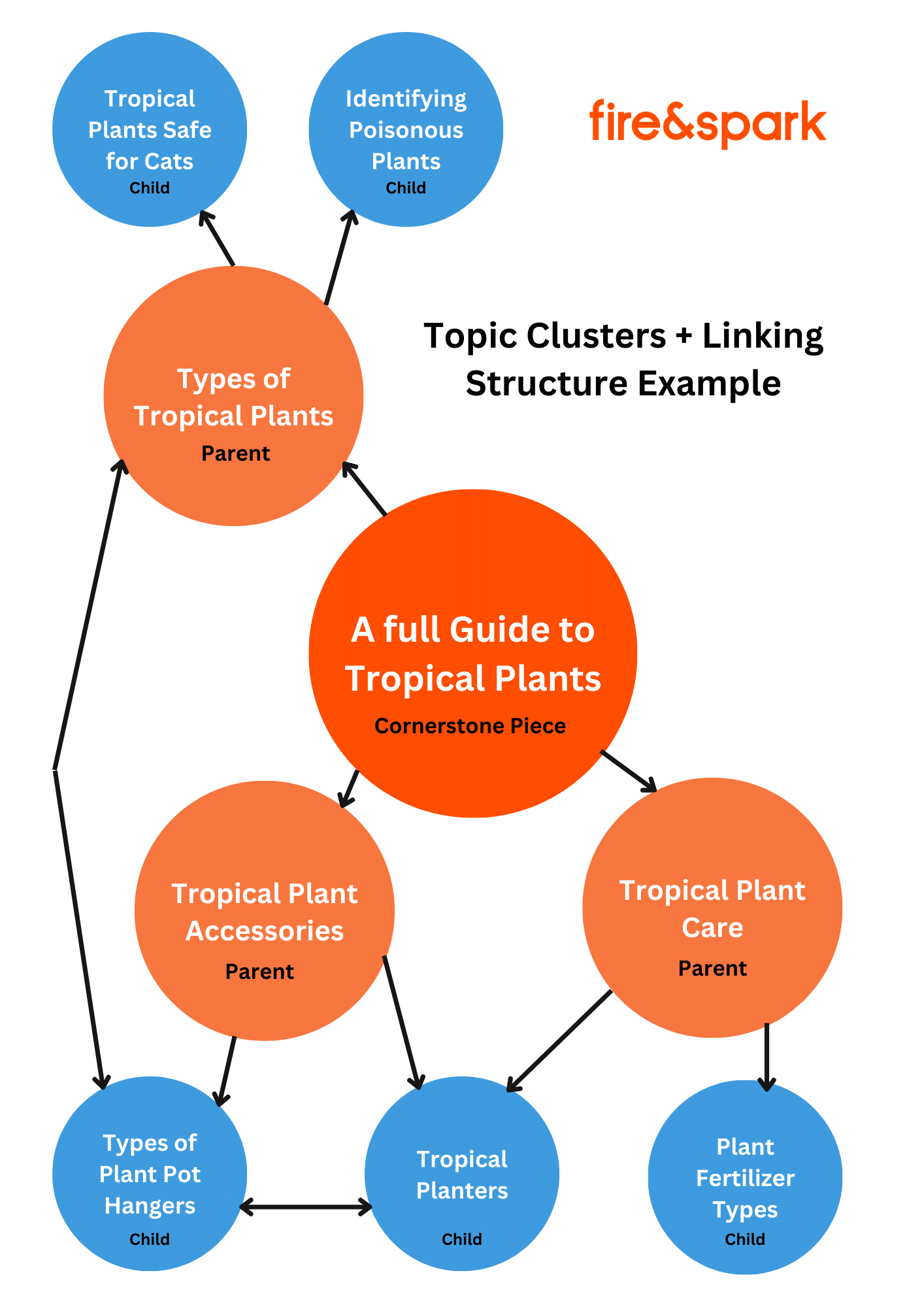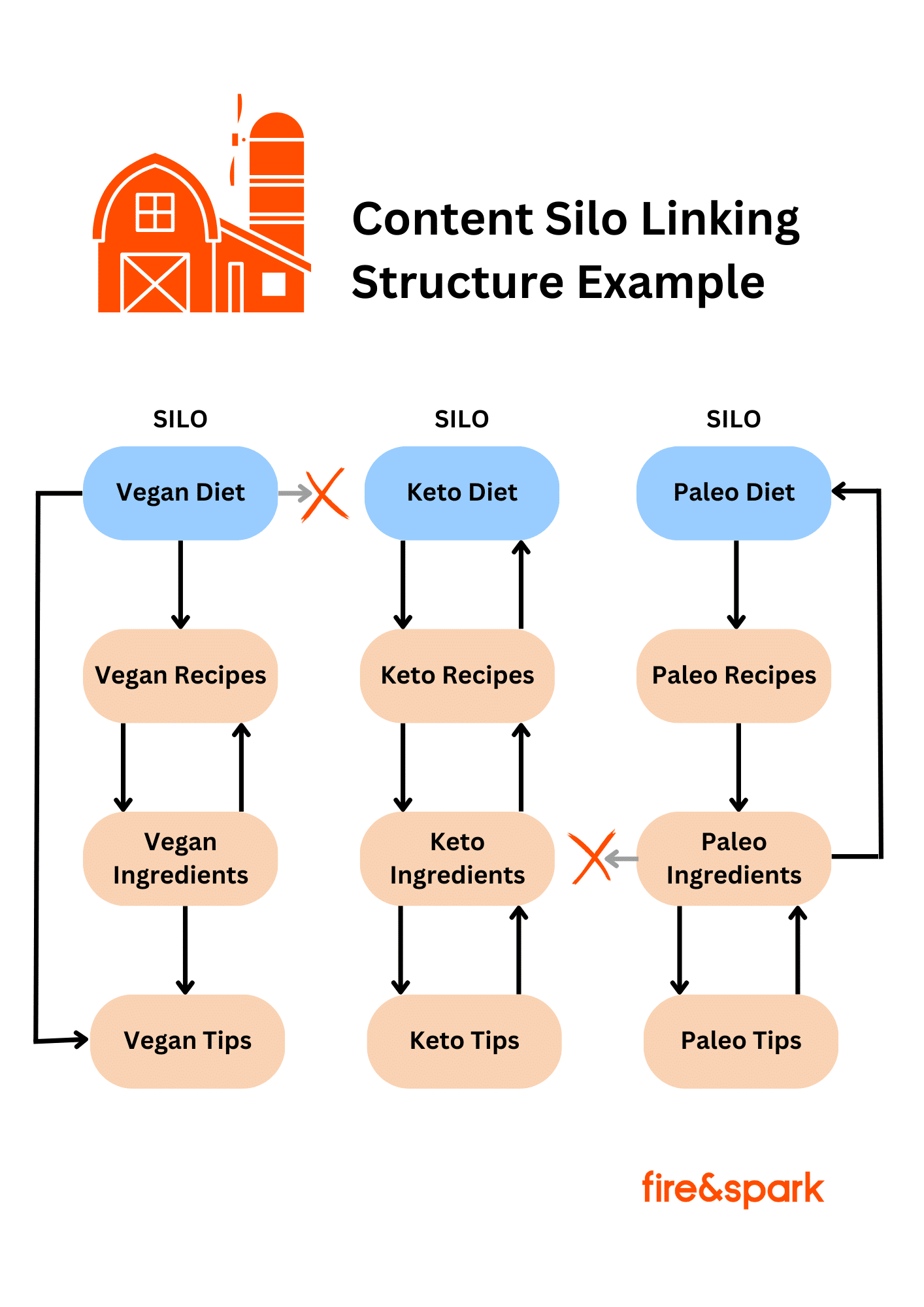Beginning to figure out the best way to create and organize content on your website can be overwhelming. Or maybe you’ve planned and implemented a content strategy that hasn’t been getting you the organic performance, engagement, or conversions that you’d like. It’s time to try something new!
Enter SEO topic clusters. This strategy, as the name suggests, involves creating a bunch of content around a specific topic to draw in your target audience, give them information they’ve been searching for, and encourage them to eventually convert.
Intrigued? Read on to learn what a topic cluster is, different organization methods of clustering content, and how this strategy can help you boost organic traffic, engagement, conversions, and keep your site visitors happy.
In This Article:
What is an SEO Topic Cluster?
What is the benefit of Clustering Content for SEO?
Do Topic Clusters help Topical Authority?
What is an SEO Content Pillar?
What is a Cornerstone Content Piece?
What is an SEO Content Silo?
How are Silos different from Content Pillars?
Are Silos better than Pillars?
Are Topic Clusters important for SEO?
How do you decide on topic clusters?
How do you measure the success of topic clusters?
What is an SEO Topic Cluster?
SEO topic clusters are interlinked pages that cover a range of subtopics falling under one broader topic. Pages within a topic cluster can be found on one main category page, but they also strategically link to each other in a way that anticipates what information the reader will be looking for next.
Below is an example of how an e-commerce website that sells tropical plants would format their topic cluster:

What is the benefit of Clustering Content for SEO?
Clustering content has many SEO benefits including a more user-friendly website structure and clearer content direction. When it comes to SEO, topic clusters can help boost your rankings because Google prefers well-organized websites that give searchers what they’re looking for and more. Some specific benefits of clustering content include:
- Accessible Structure: Have you ever visited a website that was confusing to navigate and left without finding the info you came for? Clustering your content makes it easy to prevent your site visitors from feeling the same way! Deciding on the proper linking structure for content clusters is simple and ensures that visitors find what they’re searching for.
- Better UX & More Conversions: Once you get someone to visit your website from any channel, you want to keep them there! By creating topic clusters, you can direct visitors to pages that hold even more useful information after finding what they were looking for. This not only creates a better user experience, but also gives you the opportunity to move visitors along the customer funnel through strategic content and internal linking.
- Comprehensive Content Library: Creating topic clusters allows you to host a detailed library of content on one topic in a way that doesn’t overwhelm visitors. Most topics have a broad range of subtopics people are searching for. Answering niche questions can drive organic traffic to your site, but if you were to do so on only one page covering the entirety of a topic – it would be impossible for a user to find what they need! Building out pages for subtopics allows your site to hold an in-depth body of info, without compromising readability. Plus, Google pushes content that focuses on the needs of the searcher, so not only will your pages be more helpful – but they’ll also rank higher.
- Clear Direction: Topic clusters make the ideation stage of content creation infinitely simpler! If your content focuses on covering many subtopics within one topic, you don’t have to spend as much time coming up with creative ideas to bring visitors to your site. Plus, when researching information for one page, you’ll likely stumble across even more ideas for future content.
As you can clearly see, there are loads of benefits to clustering content! This method not only helps with SEO by making your site organized and user-friendly, but also makes creating future content way easier.
Do Topic Clusters help Topical Authority?
Yes! Topic clusters absolutely help with topical authority as they allow you to build up a large body of content that covers loads of niche subtopics within your specialty that other websites probably aren’t talking about. This signals to Google that you’re a subject matter expert and your pages are worth prioritizing to searchers.
To increase your chances of search engines marking your content as authoritative make sure to include reliable references (i.e. news sources, scholarly articles), quotes from experts, and credentials – if applicable.
What is an SEO Content Pillar?
An SEO content pillar is the most built-out and general piece of a topic cluster. It should direct to your subtopic pages and stay up to date with the most relevant and accurate content on the subject. SEO content pillars should be informative and easy to navigate, but not too granular.
Since content pillars are your “main” page in a topic cluster, they should present a good amount of information to answer all the questions visitors may have. However, they should also direct to more detailed blogs on these questions since not every reader is looking for an in-depth explanation of a topic.
What is a Cornerstone Content Piece?
A cornerstone content piece is a well-rounded and comprehensive page that acts as the base of a topic cluster. Examples include informational landing pages, eBooks, and blog guides. Your cornerstone content should link to your subtopic page to give visitors the opportunity to learn even more.
To better understand this concept take a look at the Wegovy landing page built by Form Health, a medical weight loss company. This page gives a comprehensive overview of the weight loss drug’s purpose, but links out to a much more thorough informational blog post.

It also links to pages where visitors can take a quiz to learn if Wegovy is right for their needs and get in touch with a service provider.

Finally, there’s loads of FAQs, nested in their respective hubs, going into detail on insurance coverage, side effects, dosing, and more.

Cornerstone content pieces and SEO content pillars are terms for pretty much the same concept. Both serve as the main page of a topic cluster from which visitors can navigate to subtopics. Some cornerstone content SEO best practices include:
- Keep Info Up to Date: Since this is likely the page most of your site visitors will first land on, you have to ensure that all information is as accurate as possible. If your chosen topic is fast-paced and constantly changing this means you’ll have to frequently update your page!
- Anticipate Visitor Questions: Center your content around the questions you expect visitors to have and anticipate what they’ll be asking next. One strategy is to include FAQs on your page. This can take some research, but it’ll help users stay on your page longer, which helps you rank higher, and potentially navigate to other topic cluster pages.
- Promote Your Cornerstone Content: Since your cornerstone content piece is the most built out page in your topic cluster, it’s relevant to a broader range of potential visitors than your more niche content. It’s important to promote it more aggressively than subtopic pages since it can potentially gain you the highest number of visitors.
Cornerstone content pages are a great way to present site visitors with exactly what they’re looking for when they’re looking for it and build up trust in your site.
What is an SEO Content Silo?
SEO silos are a type of topic cluster that clearly demonstrates hierarchy between the main page and subtopic pages. A website can have multiple content silos, but each will only link to pages within their specific cluster. This method creates the most ‘clear-cut’ categories on your site.
How are Silos different from Content Pillars?
The biggest difference between silos and SEO content pillars is that the main silo page only links to subtopic pages, but a content pillar can link to any number of pages outside of the topic cluster. Choose a topic cluster strategy that works for you based on how interconnected your topics are.
For example, an online specialty diet store might structure their silos in the following way:

Are Silos better than Pillars?
Unless your business has divisions that don’t have overlapping target audiences, SEO silos aren’t any better than pillars. Some argue that silos are actually a harmful strategy, because interlinking pillars is a great way to help visitors navigate through your site. But again, this is dependent on the specific products or services you offer.
Purina is one example of a site that has seen success when choosing silos over pillars.
Each silo links to separate collection pages, informational blogs on pet food, and content to help choose the right food for the needs of your pet. This is a great way for them to organize their site as many visitors are only looking for one type of pet food.

Are Topic Clusters important for SEO?
Topic clusters are very important for SEO as having a large body of content covering broad and granular aspects of a topic makes it clear to search engines what your website is about. They also make your site much easier to crawl thanks to that incredibly strategic hierarchy and internal linking structure.
How do you decide on topic clusters?
Deciding on topic clusters doesn’t need to be overly complicated, but you should be strategic to choose content that will be useful for your site visitors. There are a few ways you can make this decision, but make sure to always keep your target audience in mind when strategizing.
Some popular ways to approach topic clusters include:
- Customer Personas:Try creating clusters that appeal to each of your customer personas. This way you can target each persona through different marketing tactics that you know work best for them.
- Products and Services: Make content clusters based on individual products or product/service categories. This allows you to fill your website with informative content that people might be looking for when browsing products or services. For example, if you have a company that sells outdoor gear, you could have a landing page for fishing products and another for camping products. This way your customers can find other useful products and blog posts based on their identified interests.
- Thought Leadership: Build topic clusters that hold cutting-edge ideas about the nature and direction of your industry. For example, a digital marketing agency could create content on Google algorithm changes, or news regarding how AI will shape the industry in the future.
- Individual Use Cases: If people visit your site looking for information on multiple different use cases, it’s a good strategy to create cluster content addressing them. This way you can answer a number of questions and widen your net for potential customers. For example, a meal planning and delivery company could identify that some customers use their service to meet fitness goals and other customers use their service to make sure their elderly parents receive regular meals. Building out separate content clusters for each use case would ensure that customers with vastly different goals have their questions answered.
How do you measure the success of topic clusters?
To measure the success of topic clusters, it’s important to evaluate all the content in the cluster as opposed to just looking at the performance of individual pieces. If your clusters are doing well, KPIs should rise for all or most of the interlinked pages.
Important performance indicators to watch for topic clusters include:
- Increased Average Rankings: If your content clusters are performing well, you’ll notice your topic pages rising in ranks together. New pages will also have an easier time ranking for related keywords as Google begins to better understand what your site is about.
- More Conversions and Engagement: Another way you can measure the success of your topic clusters is by keeping an eye on conversion rates and engagement metrics. You’ll know that you’ve done a job linking your pages together in a way that anticipates user actions if you see positive changes.
- Lower Bounce Rate: Seeing your bounce rate drop is also a great sign that your cluster content is successful. This signals that people are finding what they need on your website. They could be finding the info they’re searching for on the original page they land on, or by navigating to other topic pages. Looking at a customer’s entire journey on your site can help you get a better understanding of how well your internal linking strategy works.

Topic clusters are a simple, yet extremely effective strategy to get potential customers to your site and lead them to a conversion. Businesses in just about any industry can see major SEO, UX, and engagement benefits from clustering their content.
Don’t know where to start when strategizing and building out topic clusters? Contact Fire&Spark today for customized content using proven SEO strategies and top-notch content managers

